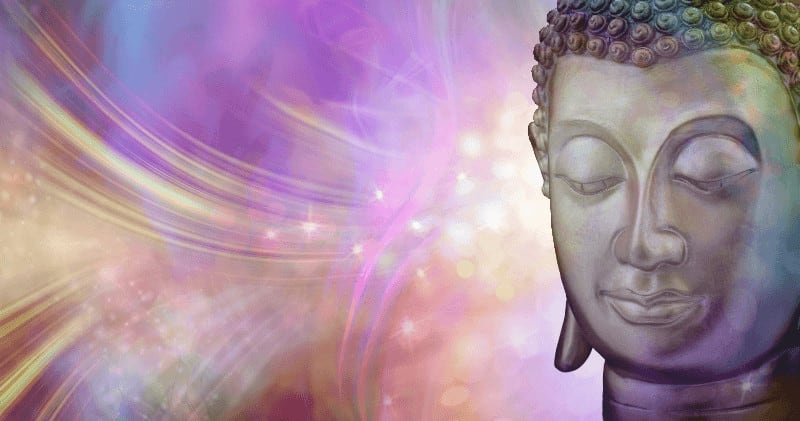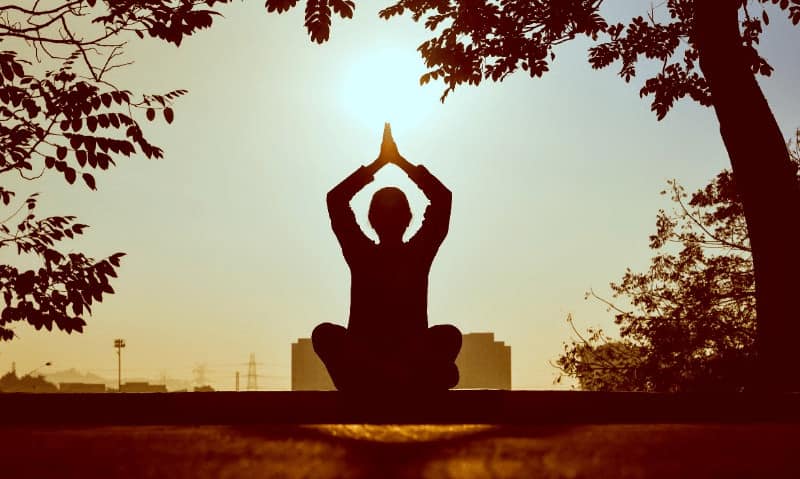What is Moksha? Unveiling the Path to Hinduism’s Ultimate Liberation
The post What is Moksha? Unveiling the Path to Hinduism’s Ultimate Liberation appeared first on The Yoga Nomads.

If you’ve been practicing or studying yoga for a while, you may have heard the term moksha tossed around in your yoga class or during philosophical discussions. Perhaps you’ve wondered, “What is the moksha” in yoga philosophy?
Moksha is a central concept in various philosophical schools and is called by its proper names: Moksha, Moksa, or Mukti. It’s a Sanskrit word with deep significance, but what does it mean?
Moksha is more than just another yogic term; it represents an ultimate goal, a state of liberation from the physical body and attachments to the material world. But how do we achieve this liberating state?
In this exploration of moksha, you’ll learn about its relationship with maya (illusion) and samsara, the endless cycle of death and rebirth. Studying different religious traditions and ancient literature provides more than one marga or path to attain this liberating knowledge. So, whether you follow the traditions and rituals of Hinduism, Jainism, or Buddhism, you can experience deliverance from suffering.
Ready to broaden your wisdom and deepen your spiritual practice? Let’s dive into the essence of moksha and discover ways to experience this profound sense of freedom.
Defining the Principle of Moksha
Moksha (liberation), also known as mukti (release), signifies the ultimate spiritual liberation and is a central concept in Hinduism and Jainism. Achieving moksha is the ultimate goal for yogis and individuals following many different spiritual paths. However, it is said to be extremely rare and requires countless cycles of reincarnation.
Even within Hinduism, the nuances of Moksha are interpreted differently within various schools of thought, like Samkhya and Dvaita, which present a dualistic view of the world. Yet the idea universally embodies attaining divine bliss through mukti: merging one’s consciousness with the divine self to obtain eternal freedom.
Similar concepts exist in other religious traditions like Jainism and Buddhism, with slight differences in terminology and concept of the self. However, no matter the marga (path) one takes to get there, moksha epitomizes freedom from material confines and realizing one’s divine self — a state of pure consciousness.
Moksha in Different Spiritual Paths
Mukti or Moksha is a crucial concept in Jainism and Hinduism, representing spiritual freedom and the realization of the human soul’s unity with the divine self. Buddhism also shares this idea of spiritual perfection and divine bliss. In this religion, however, the release from worldly suffering is called Nirvana.

Nirvana and Moksha
In Buddhism, a similar concept exists known as Nirvana. Mukti means “release”” much like nirvana refers to a candle being blown out, extinguishing attachments to material desires. Both nirvana and moksha describe liberation from the saṃsāra, the cycle of suffering and rebirth, leading to absolute freedom and peace. In comparing nirvana to moksha, we find that:
Both are states of liberation. They represent spiritual perfection. They end the cycle of rebirth.However, while moksha in Hinduism emphasizes union with divine consciousness, Nirvana in Jainism focuses on the cessation of desires and suffering. Both aim for mukti, release, or liberation from the cycle of saṃsāra.
Vimutti: Liberation in Buddhism
The Buddhist counterpart to mukti (release) is vimutti, which means freedom or deliverance. Within different schools of Buddhism, vimutti and nirvana may be used interchangeably. This concept involves the soul escaping saṃsāra, the cycle of rebirth.

The Heart of the Buddha's Teaching: Transforming Suffering into Peace, Joy, and Liberation
While vimutti and moksha (mukti) both bring ultimate liberation from all forms of bondage, there are key differences, mainly in each religion’s perspective of the self or soul.
Hinduism: spiritual liberation and divine bliss are achieved when the human soul (atman) unites with the universal consciousness (brahman). Buddhism: individuals seek the end of suffering without the process being attached to the concept of an”“unchanging sel”” or soul.To transcend the endless cycle of life and saṃsāra, the schools of Hinduism and Buddhism also propose different paths.
Approaches to Attaining Liberation
Hinduism and Buddhism propose different paths toward achieving spiritual liberation through moksha and vimutti, meaning ultimate freedom from the death and rebirth cycle.
Hinduism: Various schools suggest different means for attaining moksha, or liberation from saṃsāra, including devotion to god (Bhakti), knowledge of the soul and life (Jnana), and meditation (Dhyana), among others. Buddhism: The path towards vimutti, a state of liberating the human soul from suffering, involves adherence to moral precepts, developing concentration through meditation, and gaining insight into the true nature of reality and knowledge. In Buddhism, this is known as the Noble Eight-Fold Path.While these religious traditions have unique philosophical schools guiding their paths to spiritual liberation and understanding of the supreme being and individual identity, they converge on one central point: liberating the human soul from its finite life into a state of eternal peace and bliss in communion with God. Moksha’s Connection to Dharma and Karma
Moksha, the ultimate goal in Hinduism, is the soul’s liberation through unity with the supreme being — what some people call God. This idea is deeply intertwined with two fundamental concepts: Dharma and Karma. Each of these principles is a crucial step towards reaching lasting peace.
The Role of Dharma
In Hinduism, Dharma refers to the righteousness or virtues one must uphold in life, in devotion to the supreme being or God. Dharma serves as a means towards achieving Moksha, the soul’s liberation, by guiding our actions and decisions towards the Supreme Being.
Upholding dharma involves adherence to ethical norms and fulfilling one’s responsibilities. It governs how individuals should act in various areas of life—for example, practicing honesty, compassion, and selflessness. Following the rules of dharma is essential for a person who wishes to attain the freedom of moksha.
Influence of Karma
Karma yoga, the path of selfless action in Hinduism, directly influences one’s ability e moksha. Actions (karma) performed in life, guided by one’s knowledge of dharma, have consequences that determine our fate in saṃsāra (the cycle of death and rebirth).
Good karma leads to positive outcomes for the soul and accelerates the journey towards liberation. Bad karma produces negative consequences; any sinful action hinders progress and causes more suffering, resulting in additional cycles of reincarnation.The Dvaita philosophy in Hinduism is a dualistic school of thought that emphasizes the relationship between good karma and bad karma and asserts that all actions are individual choices made by a person, separate from the will of the Supreme Being (God).
Liberation from Saṃsāra
Achieving Moksha in Hinduism involves the soul’s liberation from saṃsāra – breaking free from the suffering we experience in the material world and release from the endless cycle of life and death. The soul’s unity with the Supreme Being or universal consciousness signifies an end to all suffering and eternal peace – a state of pure, divine bliss for the soul.
In essence:
Upholding dharma guides us on the right path toward spiritual liberation. Performing good works (good karma) in life propels our soul forward on this path of knowledge. Avoiding bad deeds (bad karma) in life prevents setbacks on the way of the soul towards moksha or ultimate freedom. Achieving Moksha liberates us from saṃsāra, the continuous cycle of reincarnation, bringing eternal peace.Role of Yoga Practices in Achieving Moksha

Yoga plays a vital role as a tool for self-realization in the passage of life towards attaining Moksha. Ancient yogis developed various types of yoga practices as means to this divine path, aiming towards unity with the universal consciousness, nurturing the soul, and deliverance from suffering experienced in the material world.
Types of Yoga Leading to Moksha
Karma Yoga: Involves selfless action and service. Bhakti Yoga: Devotional practice connecting with the divine. Jnana Yoga: The path of knowledge and wisdom. Raja Yoga: Disciplines the mind through meditation and deep concentration.Each school of yoga has its unique approach, but they all aim towards the same goal — the realization of one’s divine self, liberation of the soul, and unity with the Supreme Being. Various forms of yoga may emphasize different ideas, but in the end, the results are the same. No matter the form of yoga you choose, each offers a way to experience divine bliss.
Moksha is achieved through yoga by disciplining the senses and cultivating inner peace, ultimately leading to the state of enlightenment. Any yogic discipline is not just about caring for the physical body but extends to meditation, breathing techniques, ethical conduct, and lifestyle choices.
Meditation is a crucial part of these practices. In several religious traditions, meditation aids in attaining Moksha by quieting the mind, enhancing concentration, and promoting introspection and exploration of one’s true identity. Within the context of Hinduism and other schools of thought, regular meditation practice leads to heightened awareness of the present moment and a profound connection to the divine self or soul.
A dedicated yogi who follows yoga’s Eight-Limbed Path works through distinct stages on their way toward achieving moksha.
For example:
Asanas, or postures, focus on the present moment and prepare the physical body to contemplate. Pranayama (breath control) may either calm or stimulate the mind in readiness for the following stages of profound introspection. In pratyahara, the next stage, a yogi works to minimize distractions by withdrawing from the senses. Next, one focuses the mind through dharana or deep concentration, setting the stage for dhyana or meditation. By progressing through each of these states, ancient yogis found themselves open to receiving the liberating knowledge of divine consciousness.The journey towards Moksha through yoga is not an overnight transformation but a gradual process requiring time and dedicated practice. A wonderful place to begin is by starting a meditation practice. Using an app like Headspace can help you develop a consistent routine.
In essence:
Yogic practices across different schools of thought provide tools for self-realization and unity with the divine, leading to Moksha. Different forms of yoga cater to diverse temperaments and preferences but share the ultimate goal of universal oneness. The marga (the path or way one takes to experience self-realization) may differ, but the results are the same: liberation of the human soul from suffering. In Hinduism, yogic discipline combined with meditation paves the way for enlightenment or liberation of the soul from worldly suffering.The Four Aims of Life (Purusarthas) and Moksha
Moksha: The Ultimate Purusartha
In Hinduism and yoga philosophy, Moksha is the ultimate purusartha or aim of human life, following Dharma, Artha, and Kama. The term purusartha comes from the Sanskrit words meaning”“perso”” and”“purpos”” or”“goal”” scholars view the four Purusartha as a framework for pursuing goals in human life, helping individuals balance material and spiritual desires.
Dharma refers to moral duties and virtues. Artha relates to worldly possessions by using one’s prosperity to provide for one’s self and family. Kama represents the pursuit of pleasure in a balanced and ethical way that enhances a person’s world experience. Finally, Moksha is the ultimate liberation from all the attachments to the material world.As the final purusartha, moksha stands apart as it signifies release from the things that keep a person bound to this physical world. Seeking balance in the other three aims can pave the way for achieving Moksha. It’s like a triad where:
Following Dharma instills virtues. Fulfilling Artha ensures basic needs. Pursuing Kama balances desires.By harmonizing these goals in Hinduism, a person prepares for the final journey towards Moksha.
Renunciation: Path to Liberation
The importance of renunciation in achieving the state of moksha cannot be overstated. It involves:
Letting go of attachments to worldly possessions. Finding pleasure in liberating knowledge rather than the senses. Upholding Dharma without expecting rewards.According to many philosophical schools, including Hinduism, this renunciation is the essence of moksha or mukti. The lesson is to rise above the illusion of this physical world to ensure the soul’s passage into a pure state of consciousness.
In sum,
Balancing Dharma, Artha, and Kama forms a stepping stone towards Moksha. Detachment from worldly possessions is critical to attaining liberation or moksha.Thus unfolds the intricate interplay between the four aims of life and their culmination into the ultimate goal – deliverance from samsara, the eternal cycle of death and rebirth.

Influence of Advaita Vedanta on Moksha
Advaita Vedanta, one of the many schools of Indian philosophy, offers a unique perspective to answer “what is the moksha?” This school’s non-dualistic approach to understanding reality significantly impacts the concept of moksha.
Non-Dualistic Approach: Unlike Dvaita or dualistic schools, Advaita does not distinguish between the individual soul and the divine. Instead, its view is that they are one and the same. This idea profoundly influences how moksha is interpreted within this school of thought.
Self-Knowledge in Realizing Moksha
From the perspective of Advaita Vedanta, the role of self-knowledge in attaining moksha is crucial. Scholars of ancient literature state that understanding the individual self as inseparable from the divine is a central lesson to achieving liberation.
In this particular philosophy, self-knowledge is considered the path to liberation. The liberating knowledge that the human soul (Atman) and God or the Supreme Being (Brahman) are identical leads to unity with universal consciousness and results in spiritual liberation or moksha.
Adi Shankaracharya’s Interpretation
Adi Shankaracharya, a prominent scholar of Advaita Vedanta, offered his interpretation of moksha through his commentaries on the Upanishads. Shankaracharya’s Commentaries: His teachings emphasize that realizing our true nature — our unity with God or the Supreme Being — leads to liberation from worldly suffering and the rebirth cycle. He viewed moksa as not something to be attained but realized through self-knowledge.
In sum, Advaita Vedanta provides an impactful interpretation of what constitutes “moksha” emphasizing non-duality and self-knowledge as key aspects towards its realization.
Challenges to Attaining Moksha
Obstacles in the Path of Liberation
The journey towards moksha, or liberation from the cycle of saṃsāra (death and rebirth), is not easy. Individuals must overcome many challenges along the way. These include attachment, ignorance, and ego.
Attachment means being bound to worldly possessions, which can create a state of illusion and cloud our perception of reality. On the other hand, ignorance signifies a lack of knowledge about our true nature beyond this material world. The ego (ahamkara) represents the often distorted self-image we create and identify with.All yogis experience these obstacles in human life, but we can work to overcome them by following the traditions of yoga and Hinduism to achieve moksha.
Materialistic Desires vs Spiritual Enlightenment
Another major challenge lies in the struggle between worldly desires and spiritual enlightenment. The material world offers temporary pleasures that often lead to suffering. These earthly attachments and materialistic cravings distract us from seeking liberation.
Discipline and Self-Control
To overcome these challenges:
Live a disciplined life by following the teachings of dharma. Practice self-control and lead a balanced life using the four purusarthas as a guide.Discipline helps us keep our mind focused on the ultimate goal – freedom from suffering through moksha. Self-control assists in letting go of attachments to worldly possessions.
In essence, achieving moksha requires understanding reality beyond materialistic perceptions, taming worldly desires, and cultivating discipline and self-control.
Wrapping Up the Path to Moksha

The path towards Moksha is a complex journey that intertwines with various spiritual paths and philosophical ideas. In asking yourself,”“What is the moksha”” and reading this article, you’ve already begun your quest of liberating knowledge! We’ve covered numerous topics:
Dharma and Karma Different forms of yoga and meditation practices The Four Aims of Life (Purusarthas) The perspective of Advaita Vedanta and its influence Challenges faced during the pursuit of mukti. It’s clear that achieving moksha isn’t an overnight process but a lifelong commitment to spiritual growth and self-realization.Guided by expert insights and rooted in traditional teachings, one can navigate these complexities with time, understanding, and patience. We’ve just scratched the surface of this profound lesson and encourage readers to delve deeper into each concept for a deeper comprehension of Moksha.
As you continue your exploration of spirituality or academic study on the subject, remember that every step taken towards understanding is a step closer to attaining peace.
FAQ 1: What role does yoga play in achieving Moksha?
Yoga practices are vital in achieving Moksha as they help cultivate discipline and mindfulness and enhance spiritual growth—essential for attaining liberation.
FAQ 2: How does Advaita Vedanta influence the concept of Moksha?
Advaita Vedanta takes a non-dualistic view, meaning there is no difference between the individual soul (Atman) and God (Brahman). This philosophy dramatically influences the understanding of Moksha, merging the individual self with this ultimate reality.
FAQ 3: What are some challenges in attaining Moksha?
Challenges vary depending on personal circumstances but may include distractions from worldly desires or attachments, lack of discipline, or understanding of spiritual teachings.
FAQ 4: How do Dharma and Karma relate to Moksha?
Dharma refers to moral virtues and duties, while Karma refers to actions’ consequences. Both ideas are deeply connected to achieving Moksha—living righteously (following Dharma) leads to good Karma, which aids in attaining liberation.
FAQ 5: What are the Four Aims of Life (Purusarthas), and how do they relate to Moksha?
The Four Aims of Life are Dharma (duty), Artha (prosperity), Kama (pleasure), and Moksha (liberation). They form a balanced and fulfilling life structure, with moksha standing apart as the ultimate goal. The final stage of mukti or release offers deliverance from the cycle of birth and death.

 Lynk
Lynk 
































